This was published 5 years ago
Iran travel guide: What it's really like to travel Iran – it's not what you'd expect
By Catherine Marshall
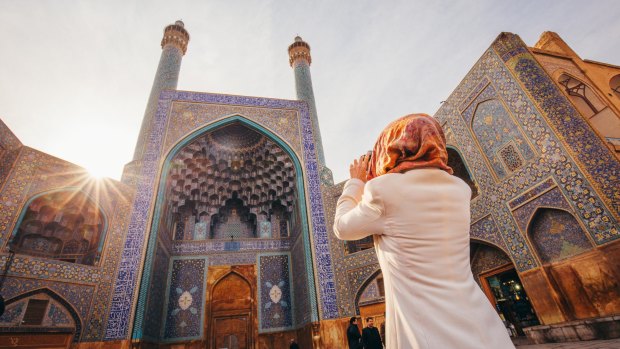
Shah Mosque on Naghshe Jahan Square, Esfahan.Credit: Damien Raggatt
It's 3am in Shiraz and a man is leaning over my shoulder as I fumble for coins in my purse. I'm panic-stricken, unable to find the money to give to the woman standing before me with outstretched hand. Beads of terror prickle my face.
"Here, let me pay," says the man at my back. He slaps a note onto the counter and the woman hands him his change as she smiles at us and slides my coffee towards me.
The stranger is graciously dismissive of my protestations: "I've lived in Melbourne," he says, eyeing my Australian passport, "and the people there have been very kind to me."
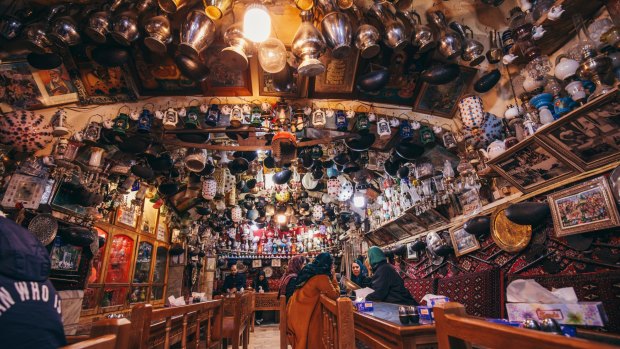
Inside Azadegan Cafe, a traditional Iranian teahouse in Esfahan.Credit: Damien Raggatt
This act of transnational reciprocity, offered as I wait for my pre-dawn flight home – the country's two-tiered currency system, in which the rial is the official unit yet most prices are expressed in Iran's colloquial currency the toman, which tricked me into thinking I had enough for coffee – is emblematic of an essential truth: Iranians are among the most hospitable and generous people you will ever meet.
What a pity, then, that we've been led to believe otherwise. Iran, as depicted in Western media, is a vision of dark political forces and unregulated nuclear weapons, radical Islamists and chauvinistic dogma; it's a country into which only the foolish venture, and where their souls are imminently imperilled.
But these fools, such as they are, are rushing in, and they're discovering that Iran is nothing at all like the hell they've been warned about. To be sure, the country possesses monumental social and political flaws (for which they are rightly condemned), but the safety of tourists is not among them. And savvy travellers understand the illogicality of condemning an entire populace for the nefarious activities of its leader (a view Americans will be pleased to hear).
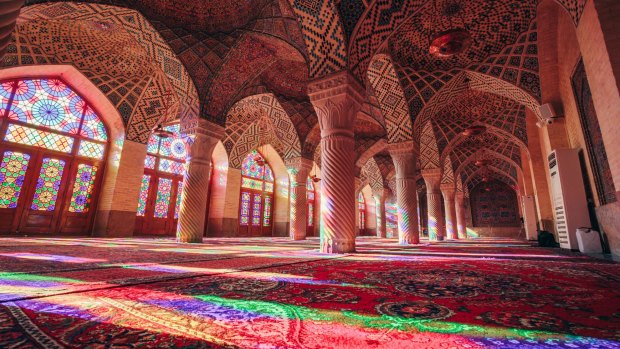
Nasir-ol-Molk, the Pink Mosque of Shiraz.Credit: Damien Raggatt
Nor can Iran be defined by almost 40 years of Islamic theocracy: this is a place where ancient trading routes, primordial ruins and religious tradition collide with voguish coffee shops, modern universities, thriving beauty salons and feisty citizens chipping away discreetly at the antiquated rules governing their lives.
TRUMP'S HELPING HAND
"Seven years ago, 400,000 people came to visit Iran," says my guide, Nadia Badiee, one of a new generation of young women making strides in the tourism industry. "Last year [2017], 4 million arrived. They come for culture, for history, for nature. Most of the people here are very nice. They still see tourists as guests."
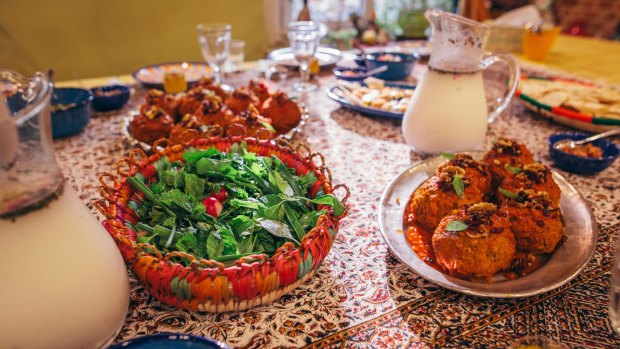
Koofteh (Persian meatballs) and doogh (traditional yogurt drink), served at a Persian cooking class in Tehran.Credit: Damien Raggatt
The country's tourism upswing appears to have been nudged by an unlikely – and unsuspecting – ally: American president Donald Trump. Instead of dissuading travellers from visiting countries such as Iran, his anti-Islamic rhetoric may well have had the opposite effect, given bookings to the region have risen by more than 100 per cent since the implementation of his Muslim-majority travel ban, says Jenny Gray, regional product manager for Africa and the Middle East at the Intrepid Group (the ban prohibits entry to the US for most people from Iran, Libya, Iran, Syria and Yemen).
"As with any growth or decline of a region, there's no way to tell for certain," Gray says. "However, we've certainly seen a steady increase since Trump's travel ban first came into play. Interestingly, at the same time we saw a sharp decline in travellers to the United States. I know there are many operators with the same sentiments. We could also attribute this to rise of consumer confidence in travelling to the Middle East."
And the trend doesn't appear to be slowing, with Iran in particular set for a strong 2019 – despite the American president's recent renewal of sanctions against the country.
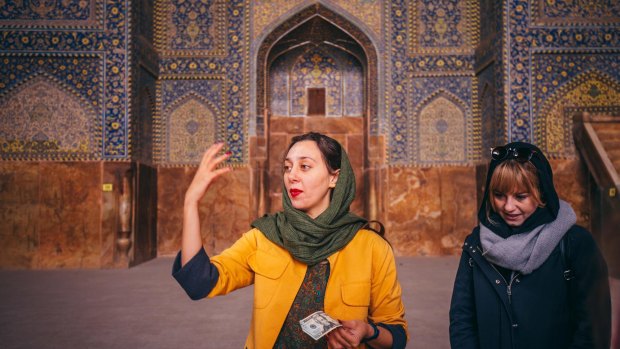
Intrepid local leader Nadia Badiee uses a dollar bill to demonstrate the strange acoustics inside Shah Mosque, Esfahan.Credit: Damien Raggatt
"Travellers are curious to see more of the world," Gray says. "The word is getting out, and [the Middle East] is a surprise for them. Everyone is looking for a place that exceeds their expectations and wrecks stereotypes."
Among the top achievers in the region are Israel, Jordan, Oman and Egypt "which has had an amazing turnaround", says Gray, and departures for Iran, still a fledgling destination, have risen by more than 17 per cent. Such is the country's growth in popularity, Intrepid introduced three new itineraries this year.
A BLESSED JOURNEY
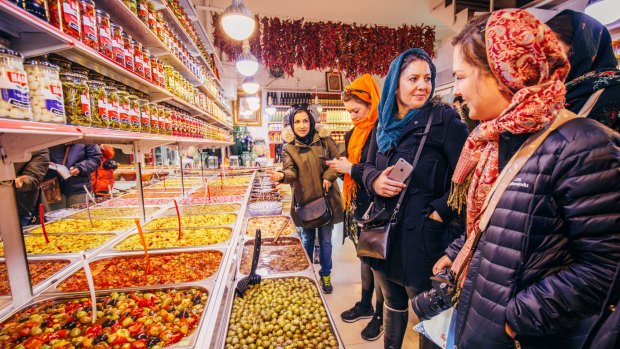
Shopping for pickles in the local market before a Persian cooking class, Tehran.Credit: Damien Raggatt
Snowflakes are powdering the passes and peaks of the Alborz mountain range when we arrive in Tehran, a city of about 10 million which swells and shrinks with the movement of itinerant traders. But the atmosphere on the streets is warm: locals lining up for sangak (flatbread baked on fire-scorched stones and removed from the oven in steaming sheets) shift to accommodate us and smile as we raise our cameras to record the baker's dexterity; giggling children shout, "Where you from?"; an old man approaches our table in a restaurant and says he's prayed for our safe journey through his country. "Welcome!" he declares in Farsi.
The old man's blessing follows us as we travel south across a barren, crumpled landscape from which roses bloom improbably each spring. Their luxuriant colour is reflected in the textiles woven in Kashan, where fabric-making is a timeworn craft. This was an important location on the Silk Road and more than 7000 textile workers spun endless bolts of silk here during the route's heyday. Today, just five master weavers remain. "The youngest," Badiee says dejectedly, "is 74."
From Kashan we climb mountain passes slick with ice and bound by terracotta buttes sweeping down to a vacant horizon. Isfahan is an oasis amid this forsaken landscape, a city where the gardens smell of cinnamon and the flower beds are crusted with snow. Sheikh Lotfollah Mosque swells like a rosebud beside Imam Square, its ornate dome and recessed entrance hinting at the epiphany contained within: a vault overlaid with hundreds of thousands of polychrome mosaics, all tethered to the feathers of what appears to be an audaciously preening peacock.
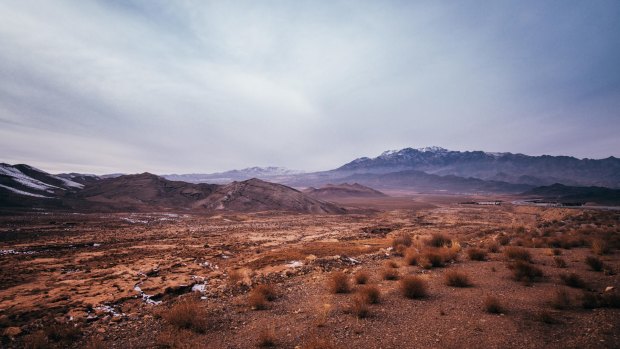
Snowy deserts on the road to Esfahan.Credit: Damien Raggatt
But modernity is always close by, elbowing its way in. A troop of schoolboys spills from Shah Mosque – a structure old beyond their imaginings yet capacious enough to contain their youthful exuberance – into the square, mobile phones held aloft, poses struck as they crowd around us for group shots. "Where you from?" comes the familiar refrain. Smiling at these younger, animated visitors, a mullah offers us sweets and thanks us for visiting.
"We're happy you are here, because you can see some of the realities of Iran," he says. "You can speak to Iranians, you can see our culture and you can make up your own mind."
INTO THE WATERLESS CENTRE
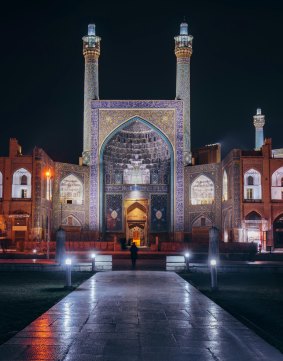
Shah Mosque on Naghshe Jahan Square, Esfahan.Credit: Damien Raggatt
My mind is made up long before we reach the central desert city of Yazd, where abaya-wrapped women beckon me to join them on a bench and pose with them for photos against the backdrop of Amir Chakhmaq Square. The mosque presiding over us enchants with an alcove-punched facade framed in tiles of blue and crowned by minarets jabbing at the sky. But really it's Zoroastrianism for which this remote, waterless city is best known. More than 1200 years ago, Badiee says, all Iranians followed this religion. Persecution in the years since has led to its decline.
But on the outskirts of Yazd, the religion's burial grounds, known as the Towers of Silence, still stand. We pass the adobe shelters where Zoroastrians would wash and dress their dead, and follow the path they would take up a hummock to the open-aired dakhmeh (tower) erected atop it. Here, they would arrange the dead bodies in concentric circles and leave them to the vultures. It's 70 years since these towers were used for open-air burial (an encroaching city necessitated their proscription). The platform offers no clue to the evisceration once brought upon it; the central ossuary contains not even a fragment of sun-bleached bone.
FRIENDSHIP SOOTHES AN EPIC JOURNEY
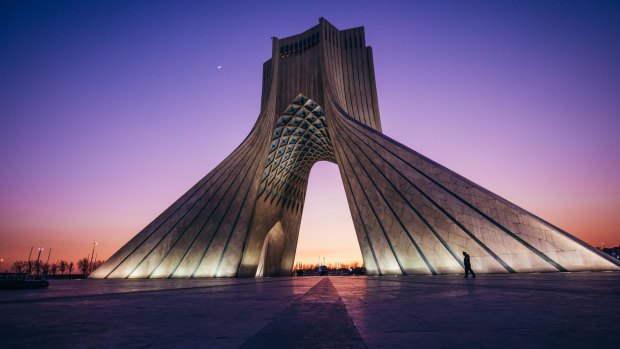
Azadi Tower at dusk, Tehran.Credit: Damien Raggatt
On the way to Shiraz we drink coffee from a roadside espresso bar, chase it with thimblefuls of rosewater and swap Instagram handles with the barista. The desert gives way to the foothills of Kuh-e Rahmat, patched together in a collage of greens and impaled with the limestone columns of Persepolis, capital of the Achaemenid Empire.
Just over the mountains, at Shiraz' Nasir-ol-Mulk Mosque (Pink Mosque) – its tilework flushed and heavy with gold, its stained glass windows casting rainbows upon the floor – we meet a couple on an epic journey. Gevelyn's Italian, Anton's Australian, and they're cycling across the world, from her homeland to his. They introduce us to their companion, a Shirazi who approached them while they set up camp a few days ago and invited them to stay with his family. Today, he's showing them the city sights.
"Who in Europe would see two cyclists," Anton asks, incredulous, "and welcome them into their home?"
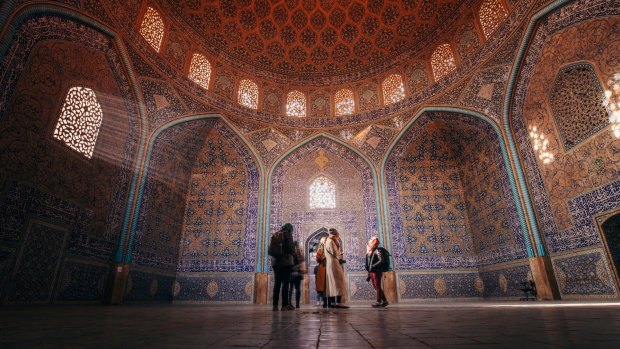
Sheikh Lotfollah Mosque in Naghshe Jahan Square, Esfahan.Credit: Damien Raggatt
We shake our heads collectively, tickled too by the culture of hospitality suffusing this country, and alarmed that we might ever have been persuaded otherwise.
FIVE OTHER WAYS TO EXPERIENCE IRAN
FOOD
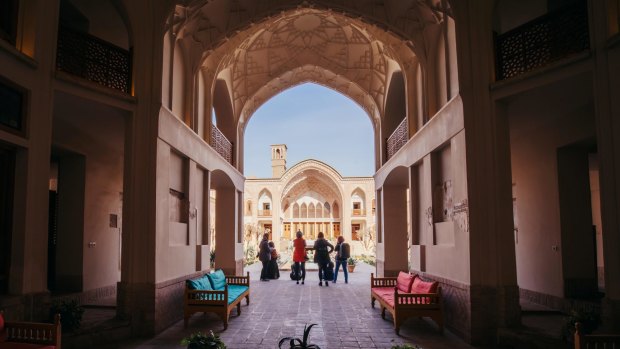
The historic Ameriha House in Kashan.Credit: Damien Raggatt
"We Iranians are not working that hard at introducing our food to the world compared to [other] cuisines," says Matin Lashkar, co-founder of Persian Food Tours. She's right: Iranian cuisine – flavoured with laboriously prepared ingredients such as garlic steeped in molasses, slow-roasted meats and Persian rice grown near the Caspian Sea – is underrated yet sublime.
HOMESTAY
The most authentic Iranian experience comes with a visit to a local's home – for several days, preferably. Homestays are growing in popularity and range from accommodation in slick city apartments to cultural immersions in the makeshift homes of nomads.
ISLAND RESORTS
Beaches don't spring automatically to mind when one thinks of Iran, but the Persian Gulf is scattered with paradisaical outcrops such as Qeshm – replete with UNESCO-listed heritage sites and marine life – and Kish, a haven of tax-free shopping and endless white beaches (specially designated beaches are available for women).
SKI
Nor does snow seem compatible with Iran, yet the slopes north of Tehran offer some of the best conditions for skiing and snowboarding: high altitude, voluminous powder and ridiculously inexpensive passes (around $US35 a day at Dizin, the region's biggest and best-known resort).
WOMEN-ONLY
Throw off your hijab as you descend the stairs into one of Iran's ubiquitous beauty salons and discover how similar Iranian women are to their Western sisters – running businesses, taking yoga classes, travelling – and yet how simultaneously regimented their lives are through clothing restrictions and facilities such as women-only parks and metro carriages.
FIVE OTHER MIDDLE EASTERN COUNTRIES TO EXPLORE
EGYPT
The winds of revolutionary change swept over Egypt during the Arab Spring in 2011 and chased its multitudes of annual visitors away. The "spring" heralded a seven-year-long winter during which the country's tourism industry, the bedrock of the economy, suffered gravely. But the political tumult has subsided and this crucible of civilisation – custodian of some of the world's most treasured artefacts – is luring visitors back. Tourism to Egypt has grown exponentially in the past year, with ancient wonders such as the Great Pyramids of Giza, Luxor's hieroglyph-lined Karnak Temple and the Valley of the Kings tombs attracting lovers of antiquity. Also popular are desert safaris, cruises down the Nile River and beachside sojourns on the Red Sea. The country's location positions it as a conduit between Africa and the Middle East, with many itineraries combining Egypt with countries such as Jordan and Israel. The presence of operators including Viking Cruises, Lindblad and Peregrine is also an encouraging sign – although visitors are urged to exercise caution while travelling in Egypt, and to avoid areas at high risk of terrorist attack. See traveller.com.au/egypt; egypt.travel
JORDAN
It's one of the safest countries in the Middle East, yet Jordan has also suffered a tourism downturn due to its location, wedged as it is between Syria, Iraq, Saudi Arabia, Palestine and Israel. But popular tourist sites are located far from any potential border hotspots, and the slump in visitors guarantees a quieter experience. The major drawcards are Petra, an archaeological treasure carved into pink sandstone cliffs and repository of thousands of years of history, the molten landscape of Wadi Rum and Aqaba, located on Jordan's narrow slice of Red Sea gulf coast and famed for its dive sites, beach resorts and historic ruins. Jordan has shouldered much of the refugee load resulting from the upheavals in Iraq, Palestine and Syria – a characteristic hospitality that is happily extended to visitors. See traveller.com.au/jordan; international.visitjordan.com
ISRAEL AND THE PALESTINIAN TERRITORIES
Long a hotbed of political conflict, this region experienced a tourism boom in 2017, with arrivals to both Israel and its occupied territories growing significantly. As the cradle of the world's Abrahamic religions – Christianity, Judaism and Islam – the region offers pilgrims and secular travellers alike the opportunity to visit sites such as the UNESCO World Heritage-listed Church of the Nativity, the Western Wall and the Dome of the Rock. Modernity is also luring visitors: the graffiti and street art (including works by Banksy) glazing the controversial barrier built by the Israelis along its border with the West Bank; the vibrant nightlife in the "city that never sleeps", Tel Aviv; the modern resorts rimming the saline-stiff waters of the Dead Sea; and the wineries and culinary scene proliferating across the region that showcases Israeli and Palestinian cuisine. With Israel and the Palestinian Territories inextricably entwined, both should be visited at once – if only to gain an insight into the complexities of the Israeli-Palestinian conflict and the ways in which their peoples are trying to forge a future. See traveller.com.au/israel; goisrael.com; visitpalestine.ps
TURKEY
There's a tug-of-war over Turkey: Europeans believe it belongs to them, while the Middle East insists it's firmly anchored in their part of the world (and to further confuse matters, western Asia has some claim on it, too). Geographically, it straddles all of these regions, though historically and culturally it is steadfastly connected to the empires of Ottoman, Ancient Greece, Persia, Byzantine and Rome. These influences and histories reveal themselves throughout the country's spellbinding mosques, cathedrals, monuments and ruins, and in natural wonders such as the white travertine terraces of Pamukkale and the melting-wax terrestrial adornments in the region of Cappadocia. They materialise in the Turkish cuisine sold at street kiosks and Michelin-starred restaurants and the wines and olive oils nurtured in the country's heartland. Following a mass exodus of tourists after a string of terrorist attacks and a coup, tourism is now on the rebound. See traveller.com.au/turkey; goturkeytourism.com
OMAN
Tacked on to the south-eastern end of the Arabian Peninsula beside neighbours Saudi Arabia, Yemen and the UAE, this sultanate is the region's quiet achiever, steadily growing its tourism industry on the strength of a well-deserved reputation for being safe, clean, hospitable and filled with a profusion of treasures. Luxury hotels lounge beside snow-white beaches in the capital city, Muscat, and swanky beachside resorts stretch out along the coastline in either direction (intrepid visitors can drive into Oman and its Governorate of Musandam from Dubai). But though crowds are instinctively drawn to the aquamarine Gulf of Oman, the country's hinterland offers an assortment of riches: the remarkable Jabal Akhdar (part of the Al Hajar range), where Damascus roses bloom each spring; Rub al Khali – or Empty Quarter – for desert safaris; and the UNESCO World Heritage-listed Land of Frankincense in the southern Dhofar region, where frankincense plantations and ancient ruins tell the story of this once priceless substance. See traveller.com.au/oman; experienceoman.om
TRAVEL IN IRAN: A GUIDE
SAFETY
Smartraveller (smartraveller.gov.au) currently recommends that travellers to Iran reconsider the need to travel due to the risk of arbitrary detention or arrest.
However, those who have visited generally report it to be a safe country in which to travel, especially for women. Street demonstrations and other hotspots should be avoided.
Editor's note: An earlier version of this article stated that the Smartraveller advice was "exercise a high degree of caution". This advice was correct at the time of writing but was changed on November 26.
CLOTHING
Women must wear a headscarf in public but the rules around clothing are more loosely applied than one would expect. You see Iranian women dressed in everything from ultra-conservative chadors to high heels, bright – and sometimes tight-fitting – clothing, lavish make-up and scarves pushed as far back on their heads as the morality police (yes, they exist) will allow. Visitors should err on the side of caution. A headscarf should be draped before getting off the plane; hair can be exposed at the forehead and ponytails can be visible from beneath the scarf on the back. Jeans are acceptable, but blouses and jumpers should be loose-fitting and wrists and ankles should be concealed. Head scarves can be removed in private homes but visitors should follow their hosts' lead. Men must wear long pants and long sleeves. Lightweight fabrics are essential for the hot summer months.
ALCOHOL
Alcohol is strictly forbidden and those found smuggling it into the country will incur severe penalties. Visitors are not likely to be searched at customs, but random bag checks can occur. That said, alcohol is sometimes served in private homes.
VISAS AND INSURANCE
Australians require a visa to enter Iran. These can be obtained upon arrival; an authorisation code should be supplied beforehand by your tour operator. Visitors must provide evidence that their travel insurance covers Iran and a letter stating as much can be requested from your insurance company. Covermore (covermore.com.au) policies provide coverage for Iran and insurance can also be purchased on arrival at one of Iran's international airports for around $US20.
MONEY
While the rial is Iran's official unit of currency, prices are usually expressed in tomans; one toman is equal to 10 rials.
TRIP NOTES
Catherine Marshall travelled as a guest of Intrepid.
MORE
FLY
Qatar flies twice daily from Sydney and daily from Melbourne and Canberra to Doha, with connections from Doha to Tehran. See qatarairways.com
TOUR
Intrepid tours in Iran include itineraries that focus on cycling, food and women-only adventures. Prices from around $2457 a person, including accommodation, transport and selected meals and activities. See intrepidtravel.com/au; for food tours in Tehran and Isfahan, see persianfoodtours.com. Follow Gevelyn and Anton's journey at instagram.com/cyclinghobOz.
Sign up for the Traveller Deals newsletter
Get exclusive travel deals delivered straight to your inbox. Sign up now.